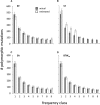Distinguishing Among Evolutionary Forces Acting on Genome-Wide Base Composition: Computer Simulation Analysis of Approximate Methods for Inferring Site Frequency Spectra of Derived Mutations
- PMID: 29588382
- PMCID: PMC5940166
- DOI: 10.1534/g3.117.300512
Distinguishing Among Evolutionary Forces Acting on Genome-Wide Base Composition: Computer Simulation Analysis of Approximate Methods for Inferring Site Frequency Spectra of Derived Mutations
Abstract
Inferred ancestral nucleotide states are increasingly employed in analyses of within- and between -species genome variation. Although numerous studies have focused on ancestral inference among distantly related lineages, approaches to infer ancestral states in polymorphism data have received less attention. Recently developed approaches that employ complex transition matrices allow us to infer ancestral nucleotide sequence in various evolutionary scenarios of base composition. However, the requirement of a single gene tree to calculate a likelihood is an important limitation for conducting ancestral inference using within-species variation in recombining genomes. To resolve this problem, and to extend the applicability of ancestral inference in studies of base composition evolution, we first evaluate three previously proposed methods to infer ancestral nucleotide sequences among within- and between-species sequence variation data. The methods employ a single allele, bifurcating tree, or a star tree for within-species variation data. Using simulated nucleotide sequences, we employ ancestral inference to infer fixations and polymorphisms. We find that all three methods show biased inference. We modify the bifurcating tree method to include weights to adjust for an expected site frequency spectrum, "bifurcating tree with weighting" (BTW). Our simulation analysis show that the BTW method can substantially improve the reliability and robustness of ancestral inference in a range of scenarios that include non-neutral and/or non-stationary base composition evolution.
Keywords: GC content; ancestral reconstruction; codon usage; nucleotide substitution; unfolded site frequency spectrum.
Copyright © 2018 Tomotaka Matsumoto, Hiroshi Akashi.
Figures







Similar articles
-
Ancestral inference and the study of codon bias evolution: implications for molecular evolutionary analyses of the Drosophila melanogaster subgroup.PLoS One. 2007 Oct 24;2(10):e1065. doi: 10.1371/journal.pone.0001065. PLoS One. 2007. PMID: 17957249 Free PMC article.
-
Evaluation of Ancestral Sequence Reconstruction Methods to Infer Nonstationary Patterns of Nucleotide Substitution.Genetics. 2015 Jul;200(3):873-90. doi: 10.1534/genetics.115.177386. Epub 2015 May 6. Genetics. 2015. PMID: 25948563 Free PMC article.
-
Inferring the Probability of the Derived vs. the Ancestral Allelic State at a Polymorphic Site.Genetics. 2018 Jul;209(3):897-906. doi: 10.1534/genetics.118.301120. Epub 2018 May 16. Genetics. 2018. PMID: 29769282 Free PMC article.
-
Mutation pressure, natural selection, and the evolution of base composition in Drosophila.Genetica. 1998;102-103(1-6):49-60. Genetica. 1998. PMID: 9720271 Review.
-
The evolution of bacterial DNA base composition.J Exp Zool B Mol Dev Evol. 2014 Nov;322(7):517-28. doi: 10.1002/jez.b.22565. Epub 2014 Mar 9. J Exp Zool B Mol Dev Evol. 2014. PMID: 24610535 Review.
Cited by
-
Dinucleotide preferences underlie apparent codon preference reversals in the Drosophila melanogaster lineage.Proc Natl Acad Sci U S A. 2025 May 27;122(21):e2419696122. doi: 10.1073/pnas.2419696122. Epub 2025 May 22. Proc Natl Acad Sci U S A. 2025. PMID: 40402244
References
Publication types
MeSH terms
LinkOut - more resources
Full Text Sources
Other Literature Sources
Molecular Biology Databases
Miscellaneous
